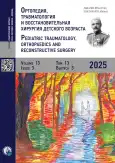一种用于评估脑瘫患儿髋臼解剖位置的新方法
- 作者: Umnov V.V.1, Novikov V.A.1, Zharkov D.S.1, Mustafaeva A.R.1, Loboda O.S.2, Pashkovsky D.M.2
-
隶属关系:
- H. Turner National Medical Research Center for Children’s Orthopedics and Trauma Surgery
- Peter the Great Saint Petersburg Polytechnic University
- 期: 卷 13, 编号 3 (2025)
- 页面: 283-292
- 栏目: New technologies in trauma and orthopedic surgery
- URL: https://bakhtiniada.ru/turner/article/view/349950
- DOI: https://doi.org/10.17816/PTORS635916
- EDN: https://elibrary.ru/IDSNDF
- ID: 349950
如何引用文章
详细
论证。目前用于评估脑瘫患儿髋臼畸形程度的方法主要只能描述其形态。而在关节逐渐失稳过程中,髋臼在骨盆环内空间取向的改变尚缺乏系统研究。
目的:基于线性指标法,对脑瘫患儿稳定及不稳定髋关节中髋臼相对于骨盆环要素的空间取向参数进行评估。
方法。开展横断面研究,纳入21名 9–15岁脑瘫患儿(共42 个髋关节)。每位患者一侧髋关节稳定(21例,第一组),另一侧为不稳定(半脱位或脱位,21例,第二组)。本研究采用作者自拟的方法,即在螺旋计算机断层扫描上通过4项作者提出的线性指标来测定髋臼的空间取向,该方法适用于稳定和不稳定的髋关节。
结果。零假设检验显示两组髋臼空间取向参数差异无统计学意义。然而,在采用定量评估方法时,不稳定髋关节组显示出以下趋势:从第1骶椎最前突点(SI)至髂前下棘、坐骨棘以及Y形软骨与闭孔嵴交点的距离缩短,而从SI至Y形软骨与耻骨嵴交点的距离则延长,与稳定髋关节组相比。逐例对比发现,这些指标在33–42%的病例中差异超过5%,具体取决于测量参数。
结论。本研究提出了一种新的诊断方法——髋臼在骨盆环内空间取向的测定。该方法能够识别髋臼的多平面移位,而不受形态学变化的限制。群体数据与个体数据之间的不一致提示需进一步研究。
作者简介
Valery V. Umnov
H. Turner National Medical Research Center for Children’s Orthopedics and Trauma Surgery
Email: umnovvv@gmail.com
ORCID iD: 0000-0002-5721-8575
SPIN 代码: 6824-5853
MD, Dr. Sci. (Medicine)
俄罗斯联邦, Saint PetersburgVladimir A. Novikov
H. Turner National Medical Research Center for Children’s Orthopedics and Trauma Surgery
Email: novikov.turner@gmail.com
ORCID iD: 0000-0002-3754-4090
SPIN 代码: 2773-1027
MD, Cand. Sci. (Medicine)
俄罗斯联邦, Saint PetersburgDmitry S. Zharkov
H. Turner National Medical Research Center for Children’s Orthopedics and Trauma Surgery
编辑信件的主要联系方式.
Email: zds05@mail.ru
ORCID iD: 0000-0002-8027-1593
SPIN 代码: 5908-7774
MD
俄罗斯联邦, Saint PetersburgAlina R. Mustafaeva
H. Turner National Medical Research Center for Children’s Orthopedics and Trauma Surgery
Email: alina.mys23@yandex.ru
ORCID iD: 0009-0003-4108-7317
SPIN 代码: 1099-7340
MD
俄罗斯联邦, Saint PetersburgOlga S. Loboda
Peter the Great Saint Petersburg Polytechnic University
Email: loboda_o@mail.ru
ORCID iD: 0000-0002-4849-8165
SPIN 代码: 4970-7018
Cand. Sci. (Physics and Mathematics), Assistant Professor
俄罗斯联邦, Saint PetersburgDmitry M. Pashkovsky
Peter the Great Saint Petersburg Polytechnic University
Email: dmpashkovsky@mail.ru
ORCID iD: 0000-0002-2218-6649
MD
俄罗斯联邦, Saint Petersburg参考
- Miller F. Cerebral palsy. New York: Springer; 2005. P. 387–432.
- Reimers J. The stability of the hip in children: a radiological study of the results of muscle surgery in cerebral palsy. Acta Orthop Scand Suppl. 1980;184:1–100.doi: 10.3109/ort.1980.51.suppl-184.01
- Chung MK, Zulkarnain A, Lee JB, Cho BC, Chung CY, Lee KM, Sung KH, Park MS. Functional status and amount of hip displacement independently affect acetabular dysplasia in cerebral palsy. Dev Med Child Neurol. 2017;59(7):743–749. doi: 10.1111/dmcn.13437
- Miller F, Slomczykowski M, Cope R, Lipton GE. Computer modeling of the pathomechanics of spastic hip dislocation in children. J Pediatr Orthop. 1999;19(4):486–492. doi: 10.1097/00004694-199907000-00012
- Kahle WK, Coleman SS. The value of the acetabular teardrop figure in assessing pediatric hip disorders. J Pediatr Orthop. 1992;12(5):586–591.
- Brunner R, Picard C, Robb J. Morphology of the acetabulum in hip dislocations caused by cerebral palsy. J Pediatr Orthop B. 1997;6(3):207–211. doi: 10.1097/01202412-199707000-00010
- Musielak B, Idzior M, Jóźwiak M. Evolution of the term and definition of dysplasia of the hip – a review of the literature. Arch Med Sci. 2015;11(5):1052–1057. doi: 10.5114/aoms.2015.52734
- Bullough P, Goodfellow J, Greenwald AS, O’Connor J. Incongruent surfaces in the human hip joint. Nature. 1968;217(5135):1290. doi: 10.1038/2171290a0
- Humbert L, Carlioz H, Baudoin A, et al. 3D evaluation of the acetabular coverage assessed by biplanar X-rays or single anteroposterior X-ray compared with CT-scan. Comput Methods Biomech Biomed Engin. 2008;11(3):257–262. doi: 10.1080/10255840701760423
- Nakamura S, Yorikawa J, Otsuka K, et al. Evaluation of acetabular dysplasia using a top view of the hip on three-dimensional CT. J Orthop Sci. 2000;5(6):533–539. doi: 10.1007/s007760070001
- Chung CY, Choi IH, Cho TJ, et al. Morphometric changes in the acetabulum after Dega osteotomy in patients with cerebral palsy. J Bone Joint Surg Br. 2008;90(1):88–91. doi: 10.1302/0301-620X.90B1.19674
- Haddad FS, Garbuz DS, Duncan CP, et al. CT evaluation of periacetabular osteotomies. J Bone Joint Surg Br. 2000;82(4):526–531. doi: 10.1302/0301-620x.82b4.10174
- Weaver AA, Gilmartin TD, Anz AW, et al. A method to measure acetabular metrics from three dimensional computed tomography pelvis reconstructions. Biomed Sci Instrum. 2009;45:155–160.
- Slomczykowski M, Mackenzie WG, Stern G, et al. Acetabular volume. J Pediatr Orthop. 1998;18(5):657–661. doi: 10.1097/01241398-199809000-00020
- Chung CY, Park MS, Choi IH, et al. Morphometric analysis of acetabular dysplasia in cerebral palsy. J Bone Joint Surg Br. 2006;88(2):243–247. doi: 10.1302/0301-620X.88B2.16274
- Kim HT, Wenger DR. Location of acetabular deficiency and associated hip dislocation in neuromuscular hip dysplasia: three-dimensional computed tomographic analysis. J Pediatr Orthop. 1997;17(2):143–151. doi: 10.1097/00004694-199703000-00002
- Gose S, Sakai T, Shibata T, et al. Morphometric analysis of acetabular dysplasia in cerebral palsy: three-dimensional CT study. J Pediatr Orthop. 2009;29(8):896–902. doi: 10.1097/BPO.0b013e3181c0e957
- Patent RU No. 2827839C1/02.10.2024. Bull. No. 28. Method of constructing to determine spatial orientation of cotyloid cavity relative to pelvic ring. Available from: https://patents.google.com/patent/RU2827839C1/en?oq=2827839 (In Russ.)
- Novikov VA, Vissarionov SV, Umnov VV, et al. Analysis of radiological parameters of the acetabulum in patients with cerebral palsy. Pediatric Traumatology, Orthopaedics and Reconstructive Surgery. 2022;10(2):143–150. doi: 10.17816/PTORS96210 EDN: GWDMNU
- Hingsammer AM, Bixby S, Zurakowski D, et al. How do acetabular version and femoral head coverage change with skeletal maturity? Clin Orthop Relat Res. 2015;473(4):1224–1233. doi: 10.1007/s11999-014-4014-y
- Sadofeva VI. X-ray functional diagnosis of diseases of the musculoskeletal system in children. Leningrad: Medicine; 1986. 238 p. (In Russ.)
- Jóźwiak M, Rychlik M, Szymczak W, et al. Acetabular shape and orientation of the spastic hip in children with cerebral palsy. Dev Med Child Neurol. 2021;63(5):608–613. doi: 10.1111/dmcn.14793 EDN: IIEMVI
- Chang CH, Kuo KN, Wang CJ, et al. Acetabular deficiency in spastic hip subluxation. J Pediatr Orthop. 2011;31(6):648–654. doi: 10.1097/BPO.0b013e318228903d
补充文件















